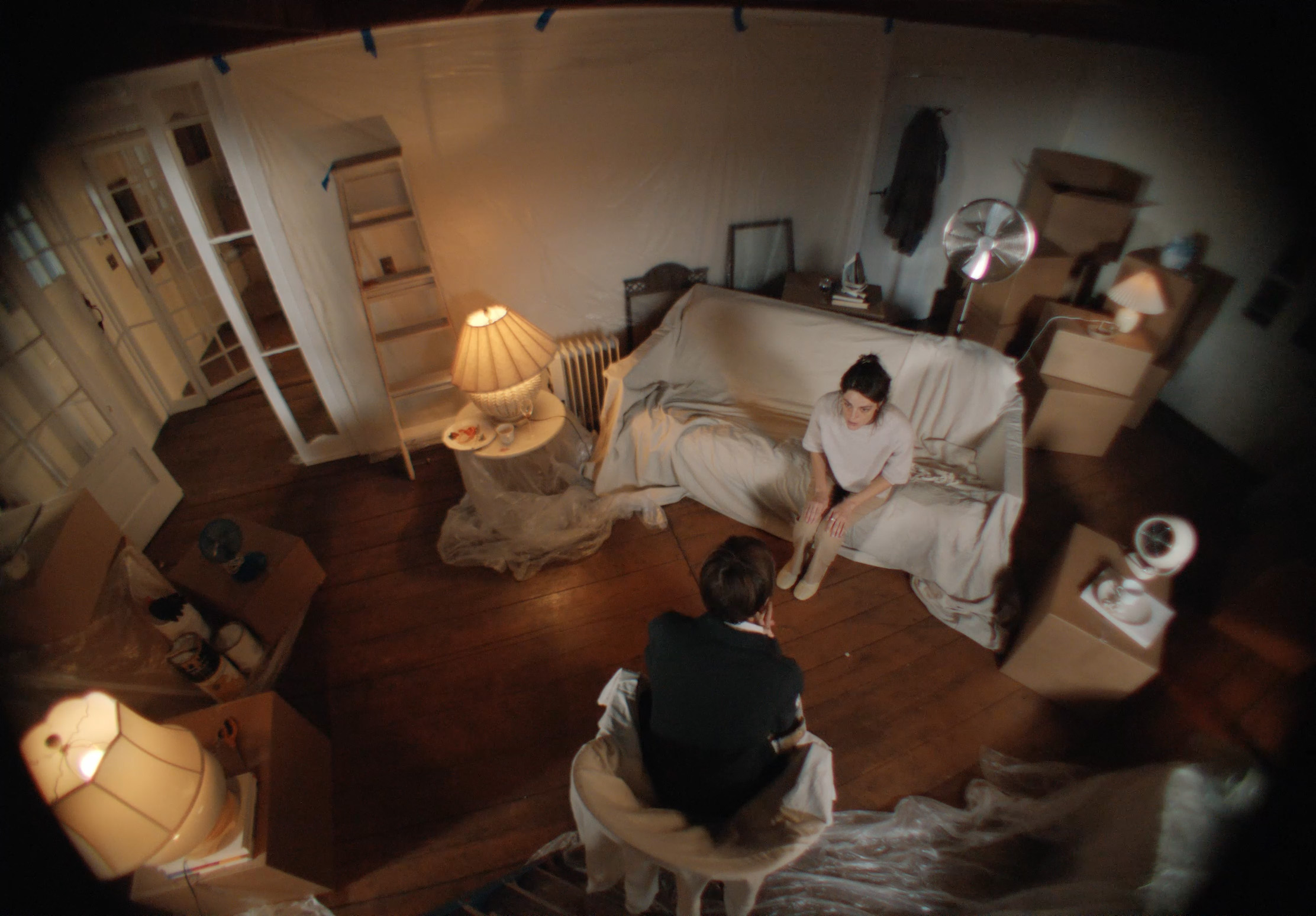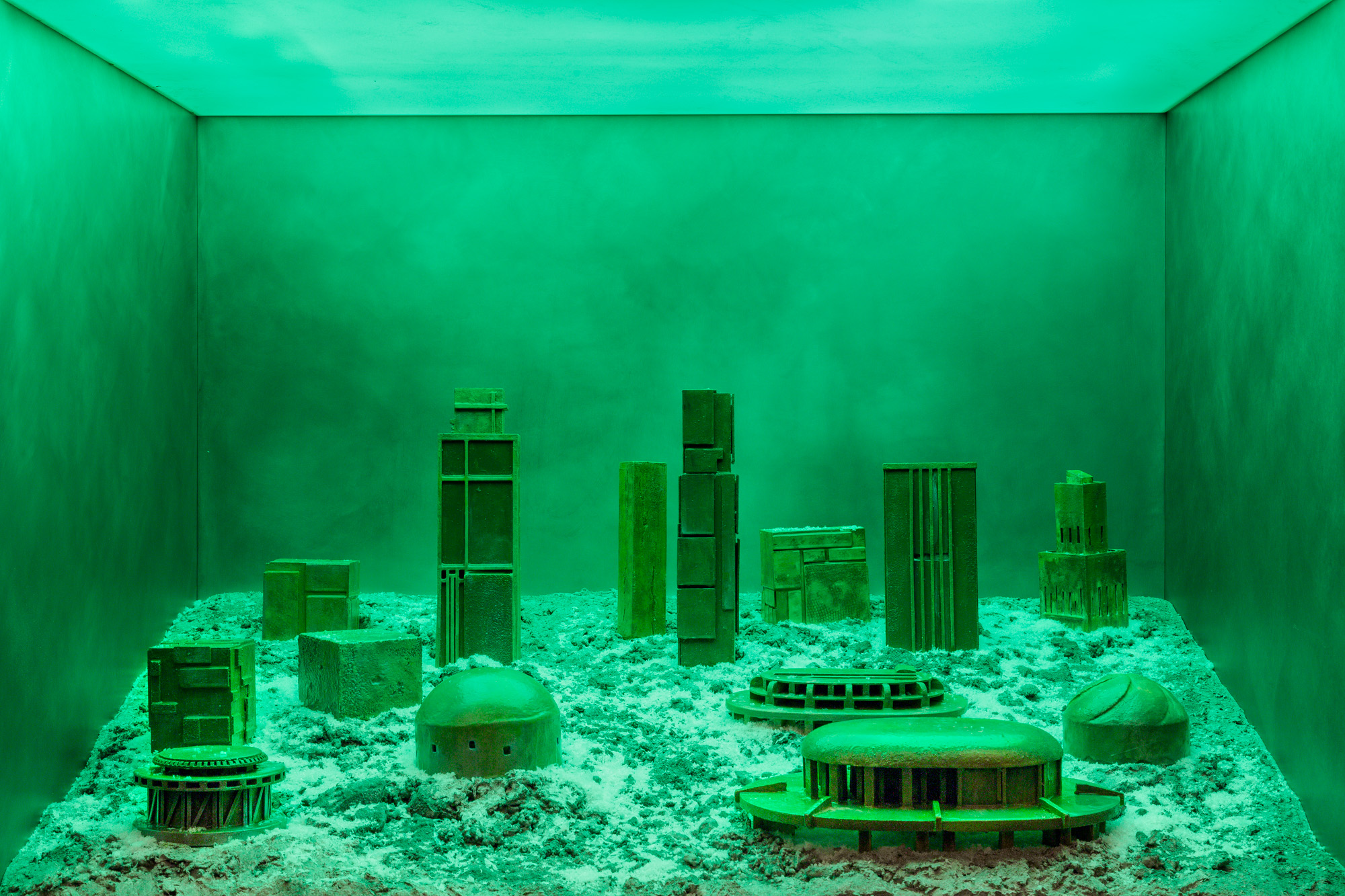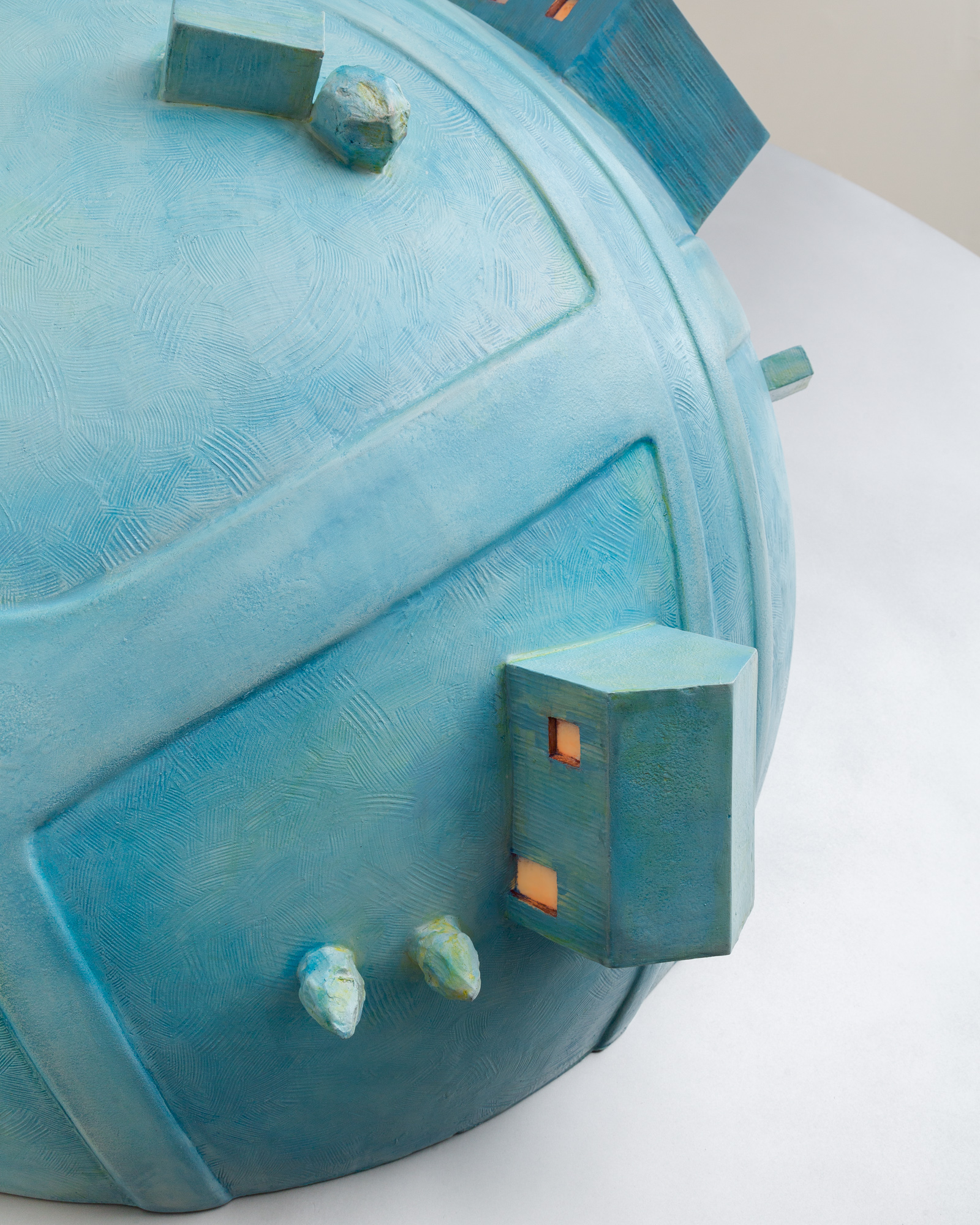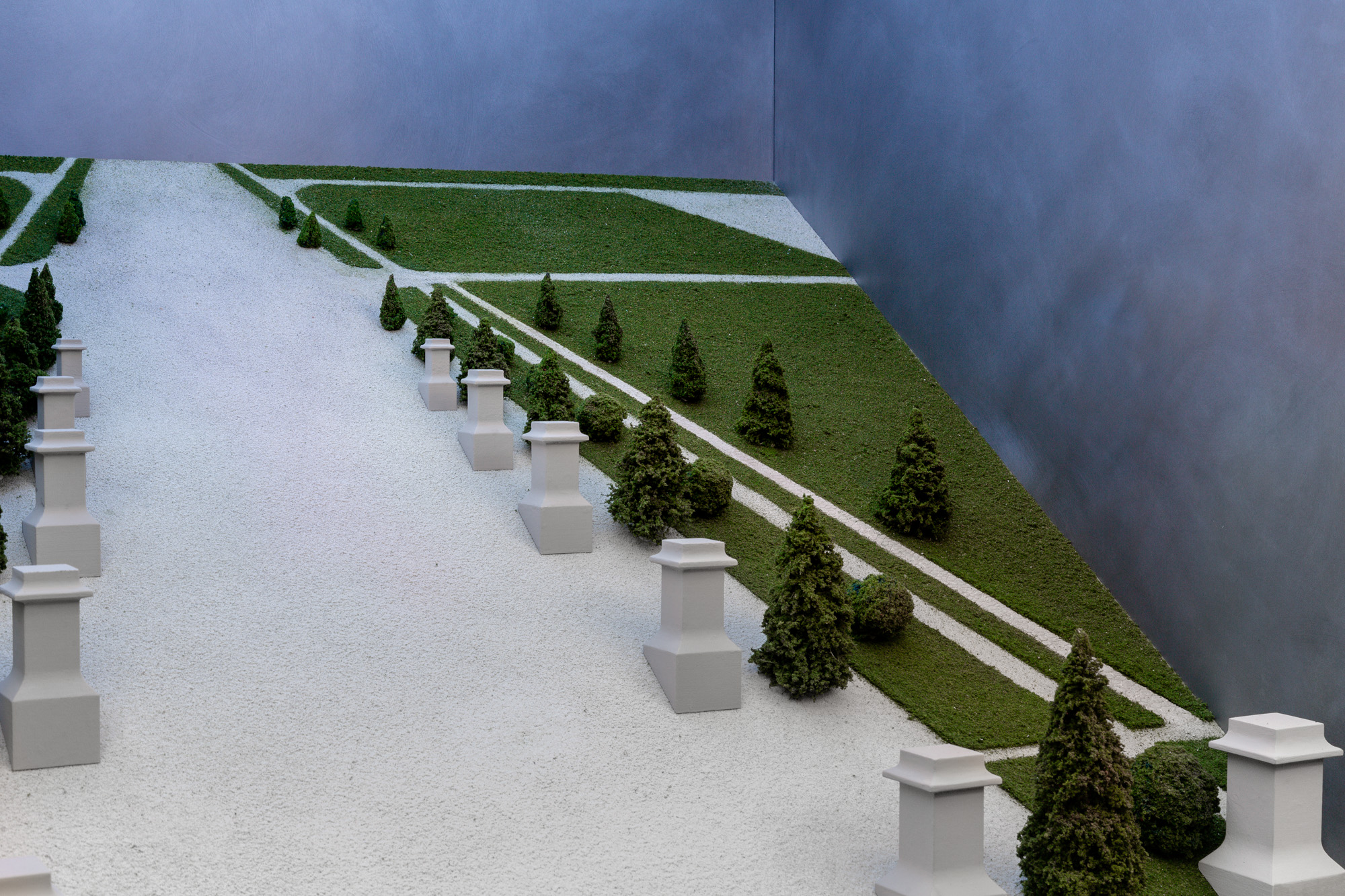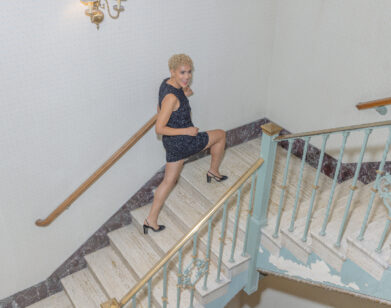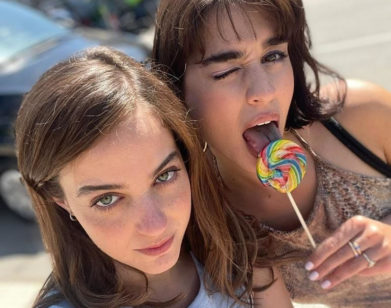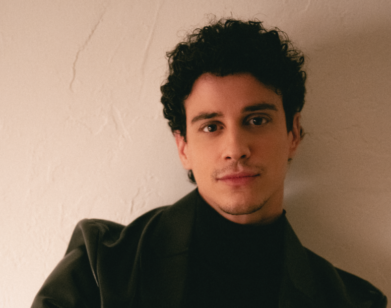IN CONVERSATION
Olivia Erlanger Invites Aubrey Plaza Inside Her Industrial Futurama
Olivia Erlanger isn’t interested in imagining dystopia. The New York artist is far more preoccupied with what she calls a “suburban noir” fantasy. Accordingly, over the past decade, her practice has flirted, utopically, with what the American dream defines as “home,” beyond the domicile. But despite her boredom with doom-and-gloom speculation, Erlanger first met her friend, the actor Aubrey Plaza, under some pretty post-world circumstances. Upon a site visit to a weed farm run by nuns in the dusty California valley where she was conducting research for a film, Erlanger discovered a zooted Plaza, who begged the artist to extricate her back to a Best Western (and later agreed to appear in the documentary). That project ultimately became Garage, an ongoing multidisciplinary collaboration with artist Luis Ortega Govela—which happened to be a huge inspiration for her new exhibition. If Today Were Tomorrow, opening this Saturday, is Erlanger’s first institutional solo show in the States, scaling an entire level of the Contemporary Arts Museum in Houston. From functional sculpture to soundscapes and film, it’s another cross-disciplinary investigation into how we design our lives in the cul-de-sac. “You love pill-popping suburban women just cutting themselves,” says Plaza, who hopped on a Zoom with Erlanger before the opening to talk haunted appliances, alter egos, and the upcoming Francis Ford Coppola epic Megalopolis.—MEKALA RAJAGOPAL
———
OLIVIA ERLANGER: Oh my god, the evil hag. She hath arrived.
AUBREY PLAZA: Hold on, don’t look at me. I have to get a tissue. I have really bad allergies. You know about my allergies…
ERLANGER: You look like you’ve reversed-aged. You look amazing.
PLAZA: No, I don’t. I’m so old. I’m going to be 40 this year. Can you believe that?
ERLANGER: No.
PLAZA: This isn’t about me. Congratulations on everything. Wait, I have to understand what’s happening. I did research, but you’re taking over an entire subterranean level of this Houston museum. Is that what’s going on?
ERLANGER: Yeah, it’s a solo show at the Contemporary Arts Museum in Houston.
PLAZA: Really? I’m going to get my ass to Houston.
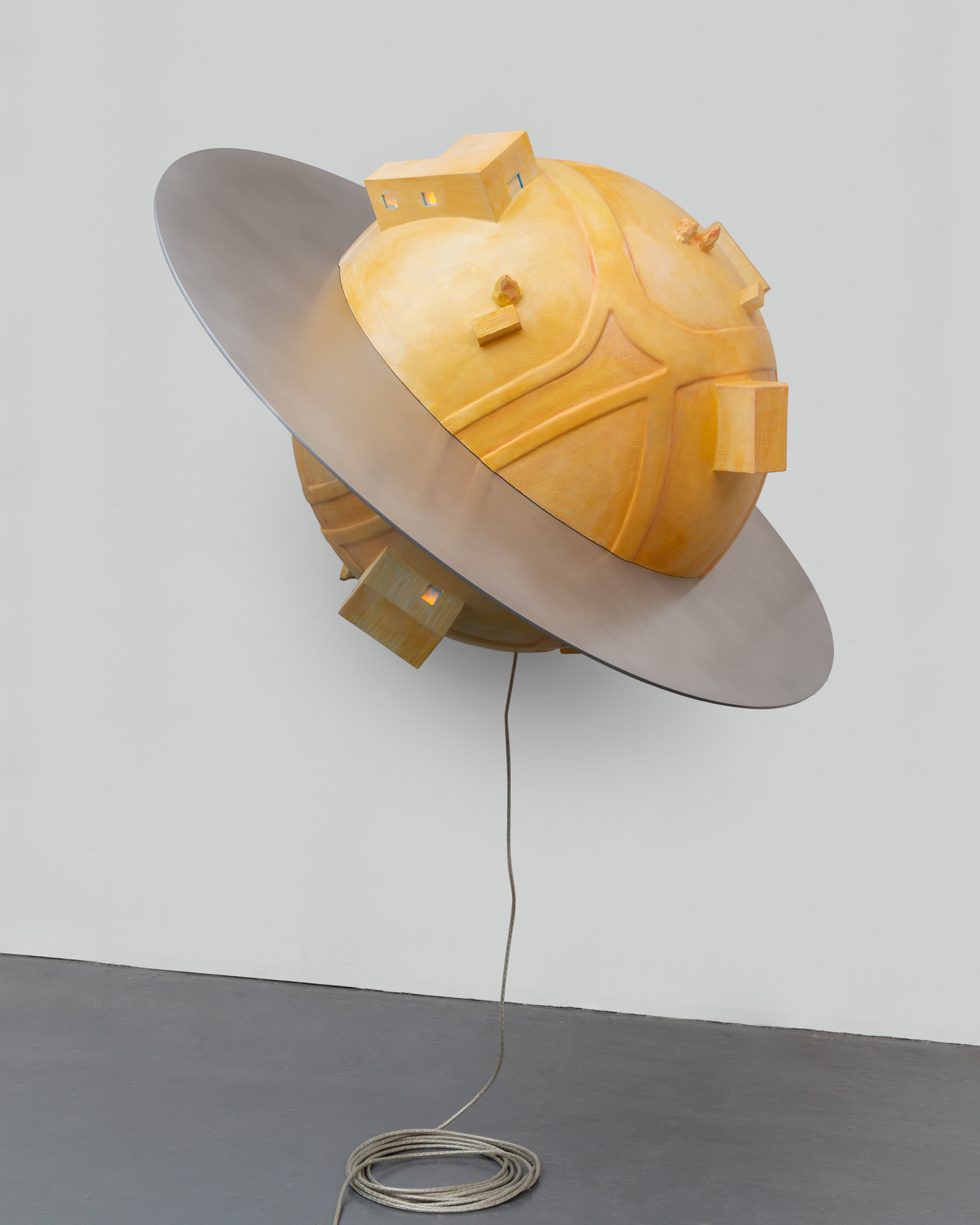
“Antimeridian,” 2024. All artwork photos courtesy of the artist and Soft Opening, London; Photography by Daniel Terna.
ERLANGER: Oh, we could definitely make it happen. When I went, I’d never been to Houston and I fully envisioned, like, mesas, Wile E. Coyote, red desert, but it is just so humid and lush. It’s a very cool city.
PLAZA: This is just a nerdy art question, but when you get that solo show, do you start making stuff for it then, or have you already done that?
ERLANGER: It really depends. This time, I met with the curator, Patricia Restrepo, in 2021. We did this studio visit and she said, “If you were to be working on a big project, what would it be?” And I literally was like, “I have worlds inside of me.”
PLAZA: Oh, yeah. Were you hitting on her?
ERLANGER: Probably.
PLAZA: I just feel like that’s kind of sexual. I don’t know why.
ERLANGER: Well, maybe it’s like gestation or something, but I didn’t know how to articulate what I wanted to make. I just knew that there were all of these stories to tell. Then I didn’t hear from her for a year and I was like, “Okay, cool. Flopped.” And then about a year ago, they invited me for the site visit and it’s a commission of all new work, so that’s how I came up with the show, If Today Were Tomorrow.
PLAZA: If today were tomorrow, I would be so fucked. Every day, if the next day was tomorrow, that would just be really bad for me.
ERLANGER: What’s going on tomorrow?
PLAZA: Oh, nothing. I don’t want to talk about it. I’m just glad it’s not today.
ERLANGER: Amen, sis.
PLAZA: I don’t know if this is valuable for this publication, but remember when we met? It’s crazy how we met.
ERLANGER: People think it’s made up. This is so classic art world. I’ve been asked if it was part of the concept to make up this crazy story of how we met, but no.
PLAZA: I was looking on your website. Honestly, I hadn’t really perused your website before, and then I saw my face and I felt really cool to be a part of your archives.
ERLANGER: Working on Garage [Erlanger and Luis Ortega Govela’s 2019 documentary film featuring Plaza] was a game changer. I feel like it set up an important paradigm for how I approach research and it was the first time I wrote scripts. I had never made a video before. It was just the first of so many different things, so it was eye-opening to the possibility of what my art could do.
PLAZA: Yes, and for the readers out there, Garage is an ongoing project and some of it’s available somewhere.
ERLANGER: It’s on Dis.art.
PLAZA: Oh, is it still? I stand by the idea that we’re not done.
ERLANGER: That’s what they don’t tell you about docs.
PLAZA: They’re never done.
ERLANGER: We need our angel investor. Calling all daddies.
PLAZA: We’ll manifest that.
ERLANGER: Actually, part of the show in Houston is this project. There’ll be my first narrative short called Appliance based off of a new body of research that I’ve been putting together.
PLAZA: Was this the one that you were texting me about when you were trying to find the DP?
ERLANGER: We worked with Mia Cioffi Henry at your suggestion, and she is a superstar.
PLAZA: Oh, fuck. I can’t wait to see that.
ERLANGER: It’s really fun. It was my first narrative short and the seed of it came out of this exhibition that I did in Vienna two years ago. I wrote a play called Humor in the Water Coolant about this woman who was haunted by the appliances in her home, so people got to speak from the position of objects. It was really fun. It’s being re-staged at ICA London in May. When I went to Houston for my site visit, we talked through my practice as a whole, and the through lines for the past decade of making art. I sound old, but—
PLAZA: Not as old as me, honey. Are you in the short?
ERLANGER: No. I don’t know about acting for me. I feel like I have a lot of opinions, which is great for directing, but I don’t know if I can do what you guys do. What you and Callie [Hernandez] and Sasha [Frolova, both of whom star in Appliance] do is incredible. You’re channeling a different energy.
PLAZA: Like Marge?
ERLANGER: Oh my god. Bring Marge back.
PLAZA: Marge is my alter ego [in Garage].
ERLANGER: Yeah. I was like, “Give me Annette Bening drunk on pills in American Beauty” and you fucking served.
PLAZA: I went for it. Can I ask you what happened to you as a child with your appliances? Did you get trapped in a washing machine?
ERLANGER: My sister definitely tried to put me in the washing machine a couple of times, maybe. I don’t know. You’re digging for early childhood trauma?
PLAZA: Yeah. [Laughs] I was thinking of that movie Safe, with Julianne Moore, when you started talking about haunted appliances.
ERLANGER: That is literally the mood board.
PLAZA: You love that shit. You love pill-popping suburban women just cutting themselves.
ERLANGER: Suburban noir. Yes. It’s like a Gregory Cruzden and Todd Haynes mashup, an ode to both of them.
AUBREY PLAZA: Did you see May December?
ERLANGER: I did. I thought it was incredible. Natalie Portman, another woman like Julianne Moore, unchanged by time.
PLAZA: Both of them, incredible. But back to the haunted appliances.
ERLANGER: Just to clarify, there’s no talking objects in the film. That would not be chic. We actually are relying on sound to precipitate their actions instead of personifying them. And there’s a short story by John Cheever called “The Enormous Radio,” which is about this woman who’s gifted a radio by her husband, but the radio is kind of cursed and the frequencies that it turns to become like x-ray vision for the apartment that she lives in so she can hear the dramas that are happening in the different rooms and it drives her mad. Sound is very important, and the sound will bleed, actually. There’s no way in the exhibition space to contain it. So you’ll be looking at new sculptures and bodies of work, but you’ll be hearing this score throughout all of it. It’ll be pretty immersive.
PLAZA: Ooh, I love an immersive experience.
ERLANGER: Does that mean you love the Van Gogh experience?
PLAZA: Sure. I love the Kubrick immersive thing. The last time I saw something like that was Paul McCarthy’s show. Did you go to that?
ERLANGER: Yeah, so good. I love his work.
AUBREY PLAZA: I was in there for a long time. So tell me about your sculpture. You don’t have to. Is it weird to talk about what you do?
ERLANGER: Yeah, definitely. As I said, in this instance, I was invited to come up with new ideas, but the weirdest thing was that I’ve had to articulate what these things are before even making them, and so much of making art is a non-verbal or a pre-verbal thing. You’re kind of going on gut instinct. For me, it’s only after the fact that I’m able to understand what the fuck I just did, basically, but in this case I’ve had to really build out the framework. But it’s been valuable because the past months have just truly been about execution. I just have to make now, which is the real pleasure.
PLAZA: Do you go into trance mode?
ERLANGER: Totally, when it’s good. Some days things don’t work and it’s horrible.
PLAZA: But when it’s working, you’re just possessed?
ERLANGER: My temporal experience is just suspended. Is it similar in acting when you’re really into a story?
PLAZA: Oh, yes. When I’m on set, there’s an unconscious thing where it’s like time doesn’t exist. When you’re shooting a movie, there’s so much stuff that surrounds the actual moments when the camera’s rolling. It’s so little time compared to all the other stuff that has to happen to lead up to that moment. There’s so much buildup and some people like all the noise. But for me, it’s just a drug. I just want to get to that one moment where I’m out of my body and I’m possessed and time has stopped, but there’s a lot of stuff that has to happen before you get to that point.
ERLANGER: Yeah, sculpture is similar. I always refer to it as a geological experience because everything just takes so much time and so there’s so many processes in terms of preparation. But once you have the condition set and all of your material and everything’s ready, then you get that opportunity to hit it the way that you’re talking about, and it’s the best feeling.
PLAZA: Yeah. Because you’re constructing out of—I don’t even know what the fuck. When I think about your mermaids coming out of your washing machines and stuff, I don’t even understand how you do it.
ERLANGER: Part of it is the process of discovery, too. I have yet to find that one thing that I’d like to make for the rest of my life. I just love problem-solving, and I think my brain is geared towards puzzles. I always say that it’s like solving some inverted riddle when I’m figuring out how to make something, but there’s also certain things that I just can’t do, and I don’t have the room for the scale of certain projects. So, for example, I’ve been working with a diorama maker, and he has been helping me actually make these hyper-realistic dioramas that are going to be set into the wall in Houston.
PLAZA: What’s the vibe of the diorama?
ERLANGER: The vibe? Each one is like a window. So much of my practice has been about the infrastructure of suburbia, the homes being interconnected by roadways, the car connecting the urban epicenter to a suburban periphery.
PLAZA: You have a whole thing about I-95, right?
ERLANGER: Yeah, it’s funny because now I feel like everything sounds really East Coast, but what can I say? That’s like my artery. But there are these large-scale planet sculptures, and I was inspired by I-95 as one of the main arteries of commerce. The planets I’ve made before are quite small and they have these arrows shot through them, but they’re illuminated and mounted on the wall.
PLAZA: They’re like light fixtures.
ERLANGER: The wires are showing, but you can’t turn them off. They’re not really meant to illuminate anything, but the larger scale ones that I’m making for the exhibition are cantilevered out from the wall. I have to send you photos. I’m really excited about them.
PLAZA: I’ve seen some of the planets with the arrows.
ERLANGER: Yeah. But the dioramas are sort of the first time that I’m really delving into this. I’ve made things in miniature. I’ve made dollhouse art using dollhouse furniture. But these dioramas are landscapes, almost proposals for a speculative future. They’re looking at property and how we delineate ownership. I wonder if you had this experience growing up in the East Coast too, but in the forest here, there’s all of these old farmers’ stone walls that were delineating property lines, but they’re half crumbling now. They’re very evocative. And then there’s another one that’s a cityscape, which is very commercial, tongue in cheek. I’m excited. It’s just fun to share.
PLAZA: Share with me.
ERLANGER: I will. There’s this project, Futurama II, from the ’60s that was in the World’s Fair, and it’s really interesting to me. It was funded by General Motors, so it’s private industry, and it was all of these dioramas of the future. Their depictions of the future were all very utopic like, “Cars changing the world for the better,” and all of those proposals for energy uses cast in a very positive light. Fast-forward to now, and we are seeing a very altered climate and kind of living inside of these closed worlds. Lydia Kallipoliti is an architectural theorist that I love, and she has a whole book about how humans navigate these systems of enclosed, climate-controlled spaces without really an experience of whatever natural world is happening outside.
PLAZA: Not to bring this back to me, but I’m going to be in Francis Ford Coppola’s movie called Megalopolis that is so up your alley because really, at the heart of it, it’s about design and architecture. I don’t want to put words in [Francis’s] mouth, but there’s a kind of idea in the movie that design can save the world. There’s this guy creating a building material called Megalon. It’s not real, but I think maybe Francis is trying to make it real. It’s this organic, invisible building material in the future. It’s all about building communities with this new material that is integrated with nature and it all kind of gels—
ERLANGER: Is it a specific proposal for a future?
PLAZA: Yes. He wrote the movie 30 years ago. He’s so fascinated with architecture and design, and—I think I’m allowed to say this—but there’s a thing in it where the homes are almost like organisms in that they move, they bloom, they open with the sun. The building material has allowed the structures to coexist with nature in a way where it’s all harmonious in a different way. It’s interesting, because the movie also tackles other stuff, like money and greed, but the core of it is design. And if you think about it, it’s how we live. If you make the way that we live better, then maybe design could change everything else. You know?
ERLANGER: Yeah. There’s a crazy connection between mortality rates and exposure to concrete. How much concrete you’re surrounded by can impact your mortality. I always talk about New York as a hologram because it’s such a cerebral landscape. It’s just such an intensely artificial space, and I feel like my experience of the natural world is so altered because of that. I feel like a lot of talk around climate chaos can get very heavy. It’s really the killer at a dinner table. You want everybody to go, just talk about climate change.
PLAZA: I know.
ERLANGER: I’m really not that interested in dystopias, and I’m more interested in utopic proposals. I can’t wait to see this movie. When will it be out?
PLAZA: I have no idea. He made it on his own. He self-financed the entire thing.
ERLANGER: I just watched The Godfather Part II, the cokey comedown to The Godfather. So good, I prefer it. And it’s Pacino, right?
PLAZA: Yeah.
ERLANGER: Pacino’s hot.
PLAZA: De Niro, yeah. You don’t have to tell me.
ERLANGER: De Niro?
PLAZA: Do you remember Dirty Grandpa De Niro?
ERLANGER: Oh my god, Dirty Grandpa.
PLAZA: I love tying your beautiful art exhibit into Dirty Grandpa.
ERLANGER: There’s one degree of separation, let me tell you.
PLAZA: Right? I’m so pumped for your exhibit. It’s really fun to know that all these people are going to be immersed in your haunted suburban nightmare. It makes me so happy.
ERLANGER: Me too. And Garage changed so much for me. It was like Saturn return for me. Plug: we are looking for your cash, angel investors.
PLAZA: Yeah, we’ve got to finish this movie. We’re pumping this out into the world again.
ERLANGER: Didn’t you just also have something at Sundance?
PLAZA: Oh, yeah. My Old Ass.
ERLANGER: Yeah.
PLAZA: Here we go. Guess who plays the part of my old ass? My old ass. It’s another indie darling movie. It’s a great movie and hopefully it’s out this summer.
ERLANGER: I can’t wait to see it.


